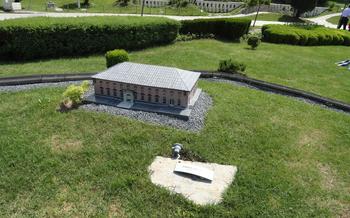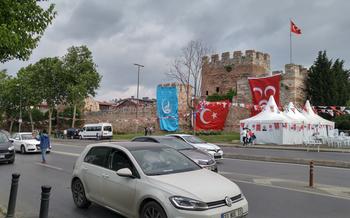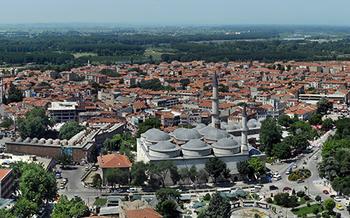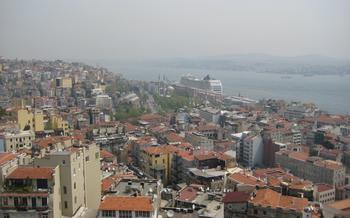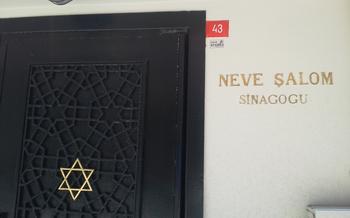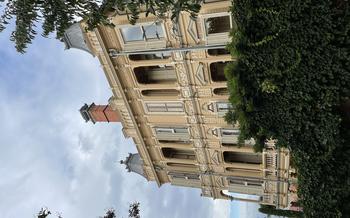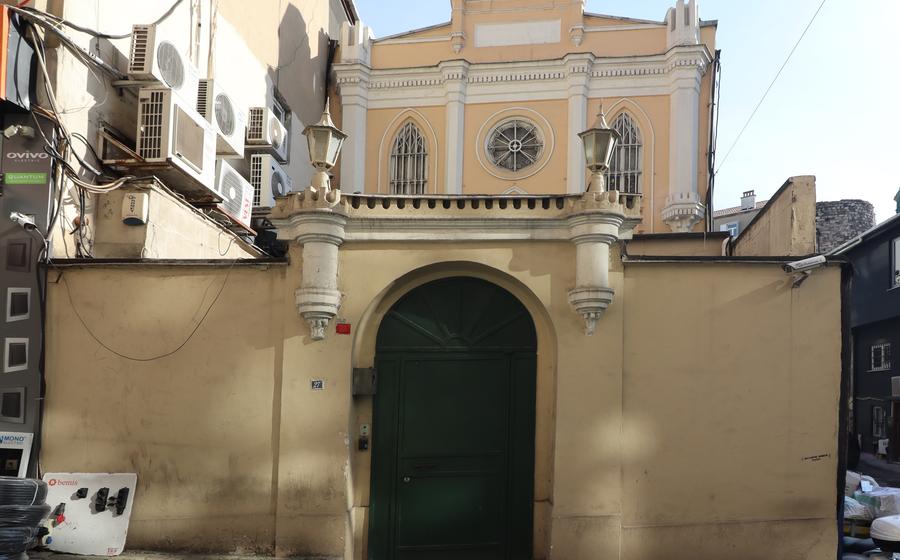
Italian Synagogue
- Historical Significance
- Architectural Features
- History and Founding
- Interior Highlights
- Religious Services and Traditions:
- Cultural Events and Exhibitions
- Restoration and Preservation Efforts
- Visiting Information
- Respect and Etiquette
- Tips for Photography
- Surrounding Area
- Personal Anecdote: A Journey Through History and Faith
- Local Cuisine
- Language and Communication
- Insider Tip: Unveiling the Secret History
Historical Significance
The Italian Synagogue, nestled in the heart of Istanbul's vibrant Balat district, stands as a testament to the city's rich cultural tapestry. Its origins can be traced back to the 16th century, when it was built by a wave of Italian Jewish immigrants seeking refuge from persecution in Europe. For centuries, the synagogue has played a pivotal role in preserving the Jewish heritage of Istanbul, serving as a spiritual and cultural hub for the city's Jewish community.
Beyond its religious significance, the Italian Synagogue embodies the spirit of religious tolerance and diversity that has long characterized Istanbul. In a city where different faiths have coexisted for centuries, the synagogue's presence stands as a symbol of mutual respect and understanding among people of different backgrounds. Its very existence is a testament to the power of religious harmony and the ability of diverse communities to thrive together.
Architectural Features
The Italian Synagogue stands out for its remarkable blend of Venetian-Gothic and Byzantine architectural styles. The exterior facade is adorned with intricate stonework, featuring arched windows, decorative columns, and elaborate carvings. Visitors are greeted by the grand entrance, which boasts a pointed arch and intricate moldings.
Stepping inside the synagogue, one is struck by the stunning interior, which showcases a harmonious fusion of Jewish and Italian architectural elements. The main sanctuary is a spacious and airy hall, with high ceilings supported by slender columns. The walls are adorned with colorful frescoes depicting biblical scenes and Jewish motifs, creating a vibrant and spiritual atmosphere.
One of the most striking features of the synagogue is the intricate stained glass windows, which bathe the interior in soft and colorful light. The windows depict a variety of subjects, including scenes from the Torah, portraits of Jewish figures, and symbols of the Italian Jewish community.
Another notable feature is the unique blend of Jewish and Italian symbolism found throughout the synagogue. The bimah, or raised platform for reading the Torah, is made of white marble and features intricate carvings of lions and eagles, representing strength and power. The Aron Kodesh, or Torah ark, is adorned with delicate floral motifs and intricate carvings, showcasing the fusion of Jewish traditions with Italian craftsmanship.
History and Founding
The Italian Synagogue has a rich and fascinating history, dating back to the 16th century when Italian Jewish immigrants fleeing persecution in Italy found refuge in Istanbul. These immigrants, known as the Levantines, brought with them their unique customs and traditions, which they infused into the vibrant Jewish community of Istanbul.
The synagogue was established in 1594 by the Levantines, who played a significant role in the development of the Ottoman Empire's commercial and cultural landscape. The Italian Jewish community flourished in Istanbul, becoming one of the most prominent and influential Jewish communities in the Ottoman Empire.
Over the centuries, the Italian Synagogue faced numerous challenges, including fires, earthquakes, and political turmoil. Despite these challenges, the synagogue remained a steadfast symbol of Jewish resilience and continuity. It underwent several renovations and expansions, reflecting the growth and vitality of the Italian Jewish community.
Interior Highlights
The Italian Synagogue boasts a number of remarkable interior features that captivate visitors with their beauty and craftsmanship. One of the most striking elements is the stunning bimah, or raised platform, made of intricately carved marble. The bimah serves as the focal point of the synagogue, where the Torah is read during religious services. Its ornate design and elevated position symbolize the importance of the Torah in Jewish tradition.
Another highlight is the elaborate Aron Kodesh, or Torah ark, which houses the sacred Torah scrolls. The Aron Kodesh is adorned with intricate carvings and decorative elements, reflecting the craftsmanship and artistry of the Italian Jewish community. The intricate carvings and inscriptions on the Aron Kodesh depict scenes from the Torah and symbols of Jewish faith, adding to the synagogue's rich visual narrative.
The women's gallery, located on the upper level of the synagogue, is another notable feature. The gallery is enclosed by ornate latticework, creating a sense of privacy and separation from the main prayer hall. The latticework is intricately designed and allows women to observe the religious services while maintaining their modesty.
These interior elements combine to create a visually stunning and spiritually uplifting space, reflecting the rich heritage and traditions of the Italian Jewish community.
Religious Services and Traditions:
The Italian Synagogue continues to be a living house of worship, preserving the vibrant traditions of Italian Jewry. Weekly Shabbat services, held every Friday evening and Saturday morning, transport visitors back to the heart of Jewish life in 16th-century Istanbul. The synagogue's interior comes alive with the melodies of ancient prayers, sung in a unique blend of Hebrew and Italian, creating an atmosphere of spiritual connection and community.
During the High Holidays of Rosh Hashanah and Yom Kippur, the synagogue transforms into a place of profound reverence and reflection. The bimah becomes a stage for stirring sermons, while the Aron Kodesh holds the sacred Torah scrolls, draped in ornate velvet coverings. The atmosphere is electric, filled with the palpable sense of unity and shared tradition.
Witnessing the religious ceremonies and rituals at the Italian Synagogue is a window into a world that has remained largely unchanged for centuries. The fusion of Italian and Jewish customs, from the melodic chanting to the elaborate processions, offers a glimpse into the rich cultural heritage of this unique community.
Cultural Events and Exhibitions
The Italian Synagogue is not only a house of worship but also a vibrant cultural center. It hosts a variety of art exhibitions, concerts, and cultural events throughout the year. These events serve as a platform for Jewish-Italian cultural dialogue and provide visitors with an opportunity to immerse themselves in the rich heritage of the community.
The synagogue has collaborated with renowned artists and institutions to curate exhibitions that showcase Jewish-Italian artwork, historical artifacts, and contemporary interpretations of Jewish culture. These exhibitions offer a unique perspective on the shared history and traditions of the two communities.
Moreover, the synagogue regularly organizes concerts featuring traditional Italian-Jewish music, classical music, and contemporary performances. These events provide a platform for talented musicians to share their art while celebrating the vibrant musical heritage of the Italian Jewish community.
By hosting cultural events and exhibitions, the Italian Synagogue plays a crucial role in preserving and promoting Jewish heritage while fostering intercultural dialogue and understanding.
Restoration and Preservation Efforts
The Italian Synagogue has undergone extensive restoration work over the years to maintain its architectural integrity and beauty. The restoration process involved collaboration with international organizations dedicated to preserving cultural heritage. This joint effort has been instrumental in preserving the synagogue's intricate details, from the delicate stained glass windows to the ornate carvings.
The dedication to preserving the synagogue is not only a testament to its historical significance but also an acknowledgment of its cultural importance. By safeguarding this unique heritage, the Italian Synagogue stands as a symbol of the enduring spirit of the Jewish community in Istanbul and a reminder of the city's rich tapestry of cultural and religious diversity.
Visiting Information
The Italian Synagogue is conveniently located in the vibrant Balat neighborhood of Istanbul, known for its rich cultural heritage. It is easily accessible by public transportation, with several tram and bus lines stopping nearby. Visitors can also opt for a leisurely walk from the iconic Golden Horn, enjoying the picturesque surroundings.
The synagogue is open to the public from Monday to Friday, with guided tours available in various languages, including English, Hebrew, and Turkish. Visitors are advised to check the official website or contact the synagogue directly for the most up-to-date information on opening hours and tour schedules.
Admission fees are typically charged to help maintain the synagogue's upkeep and preservation efforts. Visitors are encouraged to inquire about discounted rates for students, seniors, or groups.
To fully appreciate the synagogue's beauty and history, guided tours are highly recommended. Knowledgeable guides provide fascinating insights into the synagogue's architecture, history, and religious significance, bringing the stories of the Italian Jewish community to life.
Respect and Etiquette
When visiting the Italian Synagogue, it is essential to be mindful of the sacred and reverent nature of the space. Visitors should dress modestly and appropriately, avoiding shorts, tank tops, or revealing clothing. Upon entering the synagogue, it is customary to cover one's head as a sign of respect. Kippahs, or yarmulkes, are often provided for men. While inside the synagogue, it is important to maintain silence and refrain from talking or making noise. During religious services, visitors should stand when the congregation stands and sit when they sit. Photography is generally permitted within the synagogue, but it is essential to ask for permission before taking any pictures. Using flash photography may be restricted, as it can be disruptive to the services or damage the synagogue's delicate interior.
Tips for Photography
Capturing the Beauty of the Italian Synagogue
Photography enthusiasts are welcome to capture the stunning beauty of the Italian Synagogue. However, it is essential to adhere to the synagogue's photography guidelines to ensure respect and preserve the sanctity of the space.
Before taking any photographs, kindly seek permission from the synagogue's staff or tour guides. They will provide guidance on areas where photography is permitted and any restrictions that may apply.
The use of flash photography is generally discouraged within the synagogue. The bright light can be disruptive during religious services and may damage the delicate artifacts and artworks. Instead, opt for natural light or use a camera with a low-light setting to capture the synagogue's intricate details.
To capture the synagogue's grandeur, consider shooting from various angles. Experiment with different perspectives to highlight the unique architectural features, such as the intricate stonework, stained glass windows, and the stunning bimah.
The best lighting conditions for photography are during the morning or late afternoon when the natural light is soft and warm. This lighting enhances the synagogue's colors and textures, allowing you to capture its beauty at its peak.
Remember, the Italian Synagogue is an active place of worship, so be mindful of ongoing religious services or events. Maintain silence and show reverence while taking photographs, ensuring that you do not disturb the worshippers or disrupt the sacred atmosphere.
Surrounding Area
The Italian Synagogue is situated in the heart of Istanbul's vibrant Jewish Quarter, also known as the Balat district. This historic neighborhood offers a wealth of attractions and landmarks that provide a glimpse into the rich cultural heritage of the city's Jewish community.
Strolling through the narrow cobblestone streets of Balat, visitors can explore numerous synagogues, churches, and mosques, each representing the diverse religious tapestry of Istanbul. The Ahrida Synagogue, with its stunning 15th-century architecture, is a must-see for history enthusiasts. The Greek Orthodox Church of St. George, with its intricate frescoes and mosaics, offers a glimpse into the Byzantine era. The Fener Greek Patriarchate, the spiritual center of the Greek Orthodox community, is another significant landmark in the area.
Beyond its religious significance, Balat is also renowned for its vibrant cultural scene. Art galleries, boutiques, and cafes line the streets, showcasing the neighborhood's creative energy. Visitors can savor delicious Turkish cuisine at traditional restaurants, or indulge in sweet treats at local bakeries.
Combining a visit to the Italian Synagogue with a leisurely exploration of the Jewish Quarter is an enriching experience that allows visitors to delve deeper into Istanbul's rich history, diverse culture, and culinary delights.
Personal Anecdote: A Journey Through History and Faith
My visit to the Italian Synagogue was a journey that transcended time and space. As I stepped through its ancient doors, I was transported back to a bygone era, where the echoes of history whispered in the shadows. The intricate details of the architecture, the ornate carvings, and the vibrant stained glass windows filled me with a sense of awe. It was as if I were walking through the pages of a forgotten story, unfolding the secrets of a resilient community.
The synagogue's interior was a testament to faith and tradition. The bimah, with its intricate marble work, stood as a symbol of unity and devotion. The Aron Kodesh, adorned with delicate carvings, housed the sacred Torah scrolls, radiating an aura of reverence. As I observed the women's gallery, with its intricate latticework, I imagined the melodies of prayers that had once filled this space.
The visit to the Italian Synagogue was not just an exploration of a historical site; it was a profound encounter with the spirit of a community that had endured trials and triumphs throughout the centuries. I left the synagogue with a heart filled with gratitude and a deeper understanding of the power of faith and resilience.
Local Cuisine
In the vicinity of the Italian Synagogue, a diverse array of culinary experiences awaits visitors. Jewish cuisine, with its distinctive blend of Italian and Sephardic influences, offers a tantalizing journey for the taste buds. Explore the surrounding streets to discover hidden gems like kosher bakeries, traditional Jewish restaurants, and modern fusion eateries. Indulge in delectable pastries, savor the flavors of freshly baked challah bread, and satisfy your sweet tooth with mouthwatering desserts. Don't miss the opportunity to try unique dishes like the borekas, a savory pastry filled with cheese or spinach, and the pişpirik, a crispy fried dough topped with sesame seeds. Immerse yourself in the culinary heritage of the Italian Jewish community and savor the flavors that have been passed down through generations.
Language and Communication
The Italian Synagogue's staff and tour guides are multilingual, with proficiency in English, Hebrew, Italian, and Turkish. Visitors can expect to communicate seamlessly, as the guides are adept at catering to international guests. If you have specific questions or requests, don't hesitate to approach them. They are passionate about sharing the synagogue's history and significance, and are always willing to assist visitors in any way they can. To enhance your visit further, consider learning a few basic Turkish phrases. A simple "Merhaba" (hello) or "Teşekkür ederim" (thank you) can go a long way in showing your appreciation and fostering a connection with the locals. Embracing the local language, even in small ways, can create a more immersive and rewarding experience.
Insider Tip: Unveiling the Secret History
The Italian Synagogue holds a treasure trove of hidden stories that add depth and intrigue to its history. One such tale involves a concealed chamber, known as the genizah, which served as a repository for sacred texts and documents. This hidden room was used to store worn-out Torah scrolls, prayer books, and other religious materials that were no longer fit for use but were considered too holy to be discarded. Visitors who are particularly interested in the synagogue's rich history may inquire about the possibility of accessing the genizah, where they can delve deeper into the fascinating world of Jewish heritage and tradition.
